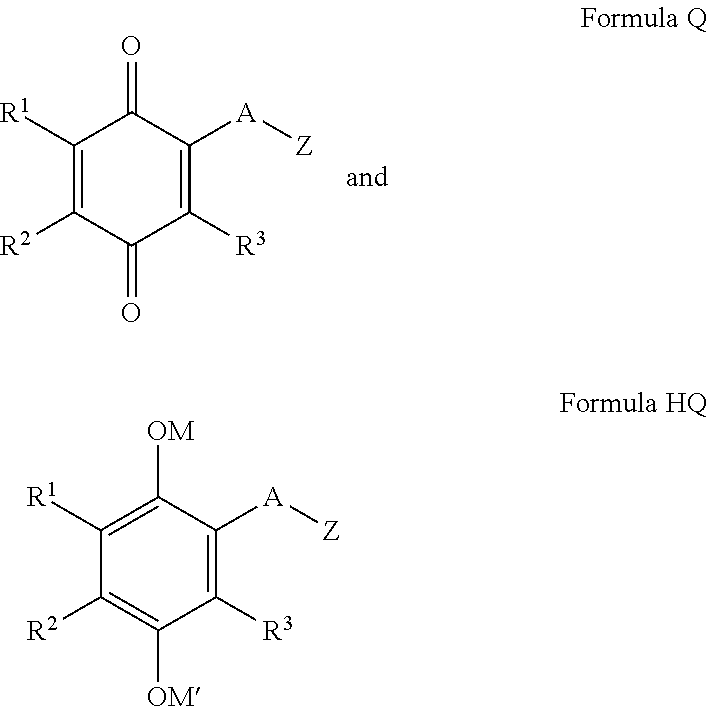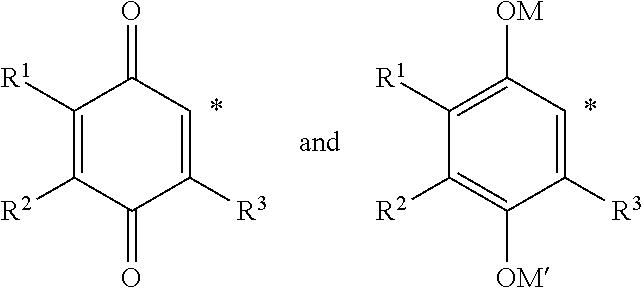2-substituted-p-quinone derivatives for treatment of oxidative stress diseases
a technology of oxidative stress disease and derivatives, which is applied in the direction of biocide, muscular disorder, drug composition, etc., can solve the problems of oxidative damage to the cellular structure and machinery, cell damage and cell death, and the rate of damage to the cell membrane exceeds the capacity of the system which controls or repairs, etc., to improve vision and hearing, muscle strength, and muscle strength.
- Summary
- Abstract
- Description
- Claims
- Application Information
AI Technical Summary
Benefits of technology
Problems solved by technology
Method used
Image
Examples
example 1
4-(Trifluoromethyl)-N-(2-(2,4,5-trimethyl-3,6-dioxocyclohexa-1,4-dienyl)ethyl)benzamide
Step 1: 1-Bromo-2,5-dimethoxy-3,4,6-trimethylbenzene
[0545]To a solution of trimethylhydroquinone (30 g, 197 mmol.) in ethanol (200 mL) was added dimethyl sulfate (33.6 mL, 405 mmol.). The brown solution was degassed with hydrogen for 10 min and cooled in an ice-water bath. To the reaction mixture was added a 10% aqueous solution of sodium hydroxide (42.6 mL, 414 mmol.), also degassed with hydrogen for 10 min. The reaction mixture was sealed and allowed to warm to room temperature over 60 min. After 60 min, HPLC analysis indicated that the reaction was complete. Excess reagent was quenched with concentrated ammonium hydroxide (150 mL) and the resulting black mixture was stirred for 30 min. The reaction mixture was diluted in water (100 mL) and extracted with methyl t-butyl ether (MTBE) (2×400 mL). The combined organics were washed with brine (50 mL), dried over anhydrous sodium sulfate, filtered, a...
example 2
1-(4-Fluorobenzyl)-3-(2-(2,4,5-trimethyl-3,6-dioxocyclohexa-1,4-dienyl)ethyl)urea
[0582]To a stirring solution of 2-(2,5-dimethoxy-3,4,6-trimethylphenyl) ethanamine (150 mg, 670 μmol), prepared as in Example 1 Step 4, in dioxane (3 mL) at 23° C. was added 4-fluorobenzylisocyanate (87 μL, 680 μmol) in one portion. After addition, the colorless solution became thick and viscous and a brown color developed. HPLC analysis after 15 min indicated that the reaction was complete. At this point, excess reagent was quenched with 2.5 M aqueous potassium carbonate (5 mL), and the reaction was diluted with ethyl acetate (10 mL). The organics were removed, washed with brine (5 mL), dried over anhydrous sodium sulfate, filtered, and concentrated in vacuo to give 180 mg yellow solid. The resulting urea (150 mg, 500 μmol) was used without further purification. The material was taken up in 2.5 mL dioxane with 1 mL water, and to the resulting solution was added ceric ammonium nitrate (550 mg, 1.1 mmol,...
example 3
4-Oxo-N-(2-(2,4,5-trimethyl-3,6-dioxocyclohexa-1,4-dienyl)ethyl)piperidine-1-carboxamide
[0591]In a 20-mL scintillation vial, 2-(2,5-dimethoxy-3,4,6-trimethylphenyl)ethanamine (300 mg, 1.34 mmol) and carbonyldiimidazole (260 mg, 1.61 mmol) were dissolved in 6 mL dioxane. The solution was stirred at ambient temperature for 15 min, when HPLC analysis indicated that an activated intermediate had formed. To the solution was added 4-piperidinone (270 mg, 1.74 mmol) and the resulting mixture was warmed to 80° C. After stirring for 1 hr, HPLC analysis indicated that the reaction was complete. The mixture as diluted with ethyl acetate (12 mL), washed successively with water and brine (5 mL each), dried over anhydrous sodium sulfate, filtered, and concentrated in vacuo to give 470 mg orange oil which was oxidized without further purification. The oily urea intermediate was dissolved in acetonitrile (6 mL) and the resulting solution was diluted with water (3 mL). To the solution was added ceri...
PUM
| Property | Measurement | Unit |
|---|---|---|
| temperatures | aaaaa | aaaaa |
| temperatures | aaaaa | aaaaa |
| temperatures | aaaaa | aaaaa |
Abstract
Description
Claims
Application Information
 Login to View More
Login to View More - R&D
- Intellectual Property
- Life Sciences
- Materials
- Tech Scout
- Unparalleled Data Quality
- Higher Quality Content
- 60% Fewer Hallucinations
Browse by: Latest US Patents, China's latest patents, Technical Efficacy Thesaurus, Application Domain, Technology Topic, Popular Technical Reports.
© 2025 PatSnap. All rights reserved.Legal|Privacy policy|Modern Slavery Act Transparency Statement|Sitemap|About US| Contact US: help@patsnap.com



